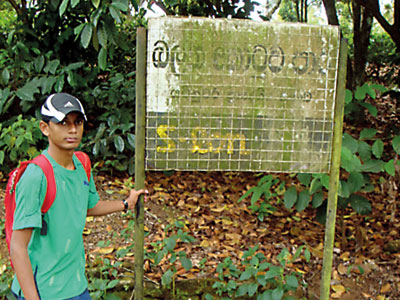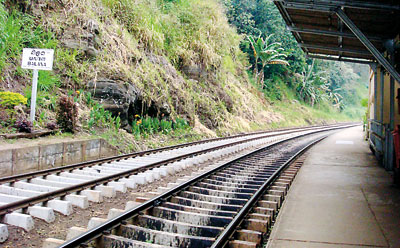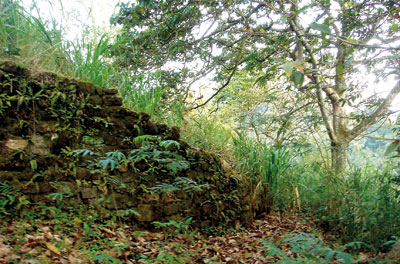When my family and I came to Kandy for the holidays I was determined to find the stronghold of Balane, that once all-important position in the Kandyan Kingdom. We got some information from the hotel manager who suggested we take a train from Kandy to Balane station (the next station after Kadugannawa, towards Colombo) and from there hike up the mountain as the road which one could enter from Kadugannawa is not easily motorable.
The next day, having got up early we drove to the Kandy station, left the car there and got into the train which left sharp on time at 6.30 a.m. After the Kadugannawa station, the environment started to change and gradually the Balane Pass with its breathtaking view became visible in the distance.
We reached Balane station around 7.20.a.m. The Station Master told us the ruins of the fort were about three kilometres up the hill and that there was a board showing the path to the ruins. He then pointed towards a narrow road on the other side of the railway line and said that if we were lucky we might catch a three-wheeler on the way up. There was a train back from Colombo at 1 p.m.
And so my father and I started up the steep road. The walk was so quiet and lonely, except for a few houses scattered amongst the thick jungles which covered the entire mountain, there wasn’t a single soul in sight. After walking some distance, we looked for a place to have breakfast and came across small boutique.
About two kilometres up the mountain, we hailed a three-wheeler. When we got closer to the area the driver showed us an adjoining mountain top which had a temple and said that there was a tunnel connecting it to the fort that had been opened in the recent past but was now closed again by the authorities.
As we came to a bend he stopped the three-wheeler and showed us the sign board which says “Balane kotuwa para” . It turned out to be a narrow footpath going up through a small tea estate. As we climbed up the path we could see stones heaped up in some places to stop the soil getting washed down. Some seemed to be from the fort itself. And as we came up to the top, there hidden among the trees lay the ruins of the once mighty Fort of Balane where thousands of brave men had sacrificed their lives to protect this pass, the key to the Kandyan Kingdom.
There are two main entrances to the stronghold of Sinhalaya – the Galagedara pass and Balane pass; Balane is the famous one as it was the main objective of European armies invading the Kandyan kingdom. The defence of this pass was entrusted by the King to the Maha Dissawa of the Great Sathara Korale. In his book ‘Ceylon and the Portuguese’, Sir Paul E. Peiris says the fort, covering an area of three acres, had four bastions and only one entrance. “An army of an estimated 8000 lay within and without; protected by two lines of tranqueira with their banquette. The gate was at the base of the crag and lay under a bastion which commanded a view of the approach up the mountain, which was by an exposed path, narrow, rugged, steep and long.”
In ‘Ceylon and Her People, Vol1’ N.E. Weerasooriya writes that “ the Balane Pass was never sold except on one single sordid instance (AD 1765) when a Mudaliyar led the flying Dutchman to safety through a by-path. The Balane Pass also never fell to the enemy except on two occasions, one being the ill-fated expedition of the Portugese in 1603 who held it for a very short time and the other when the British captured it in 1815.
At the very top of the mountain we came across the ruined walls of the - rather small, probably inner fort.
The entrance is very narrow and flanked on either side by two large circular bastions. The height of the walls at the bastions is about six to seven feet and the adjoining walls vary in height due to the different levels of elevation.
It is clear from the overgrown weeds that this historic site has not been maintained in recent years. Even the signboards have been removed, leaving only the iron frame.
We climbed down the tea estate and continued down the road where we soon found another three-wheeler, the driver telling us how they frequently find rusted cannon balls when cutting foundations for construction. Travelling some five km we reached the Kadugannawa railway station from where we took a bus back to Kandy.
This Balane Fort is a ‘must-see’ site for all who love adventure and those who cherish this country’s proud history as visiting this site is a way of acknowledging all those brave men of Balane who laid down their lives for our country’s independence. We hope the authorities will take the necessary action to preserve this fort, which was the key to the last Sinhala Kingdom.
(The writer is a Grade 12 student of St. Joseph’s College)
|




